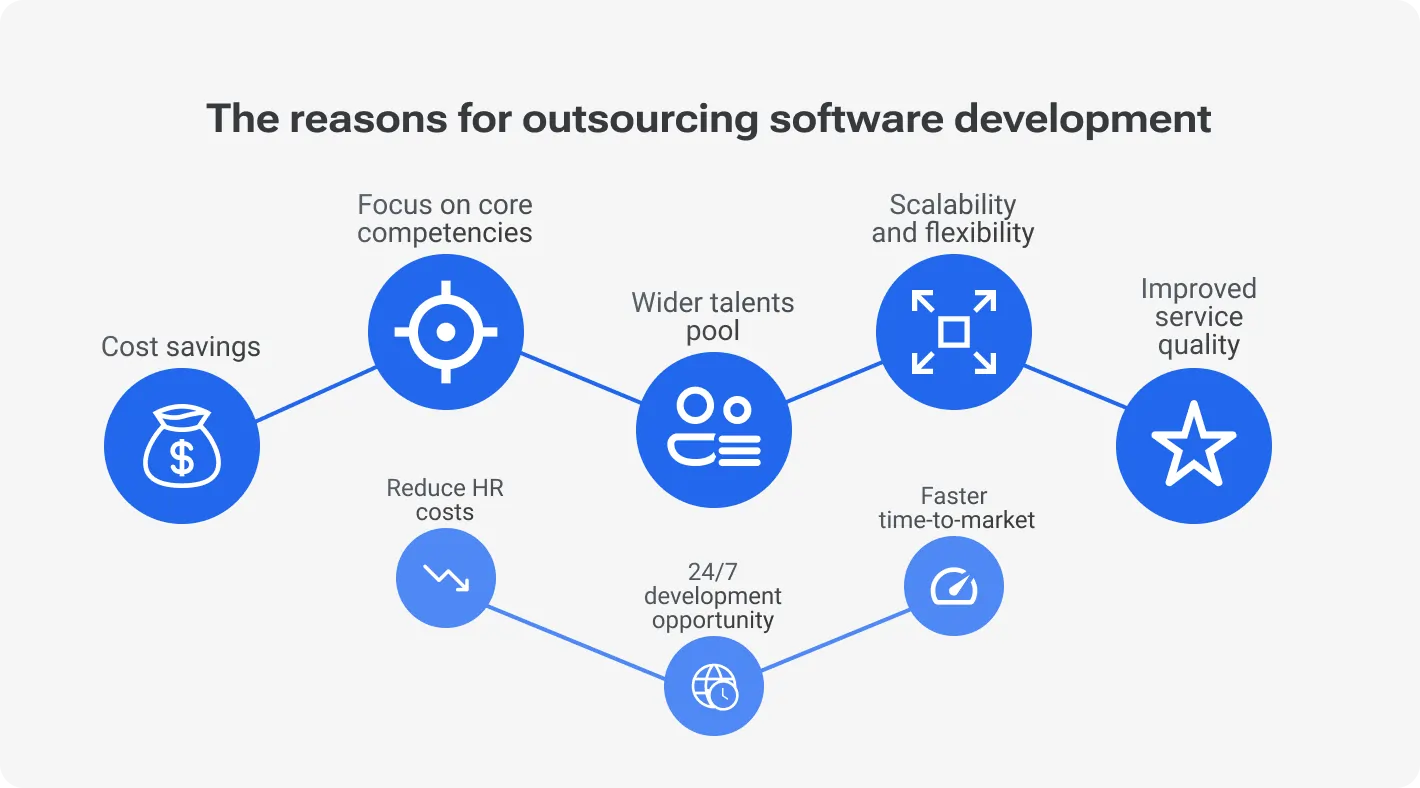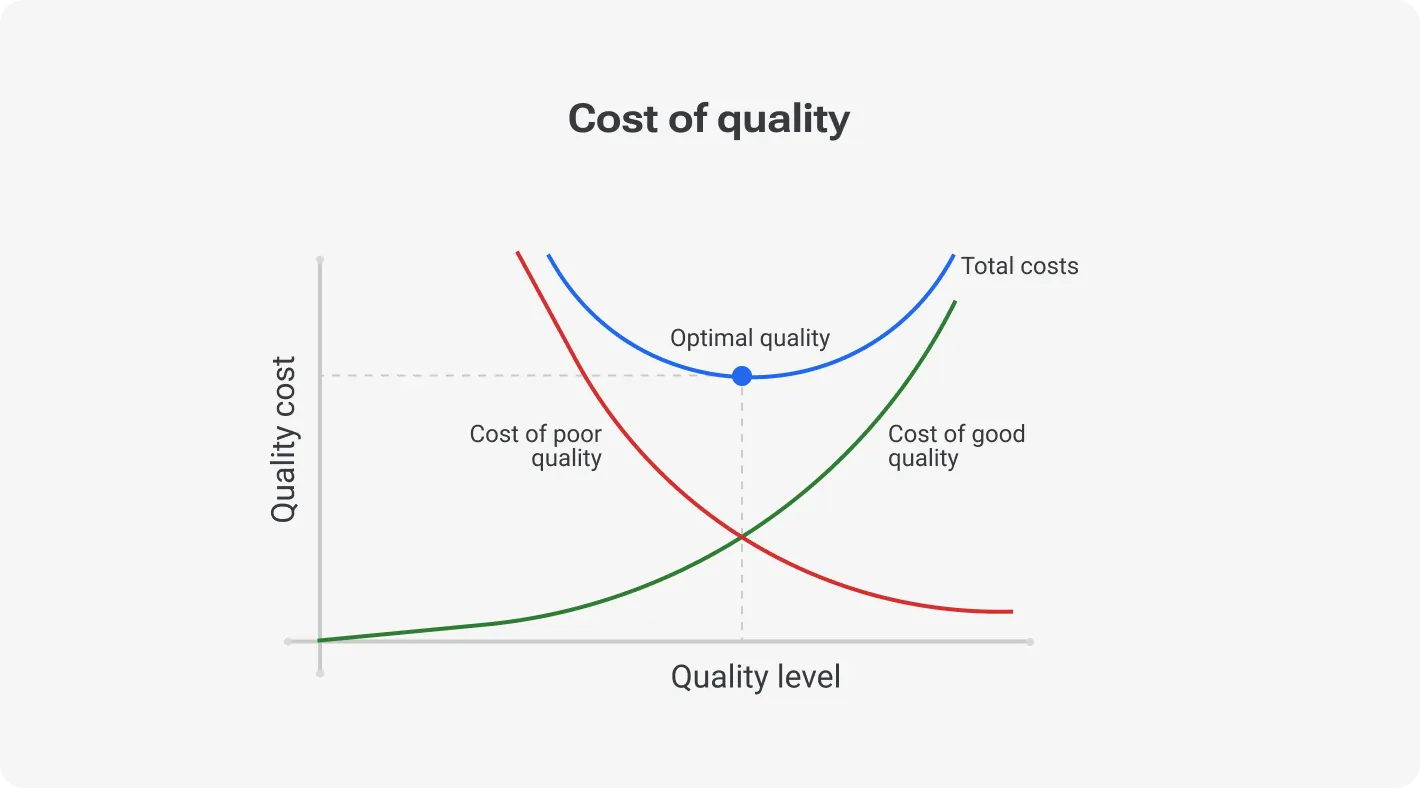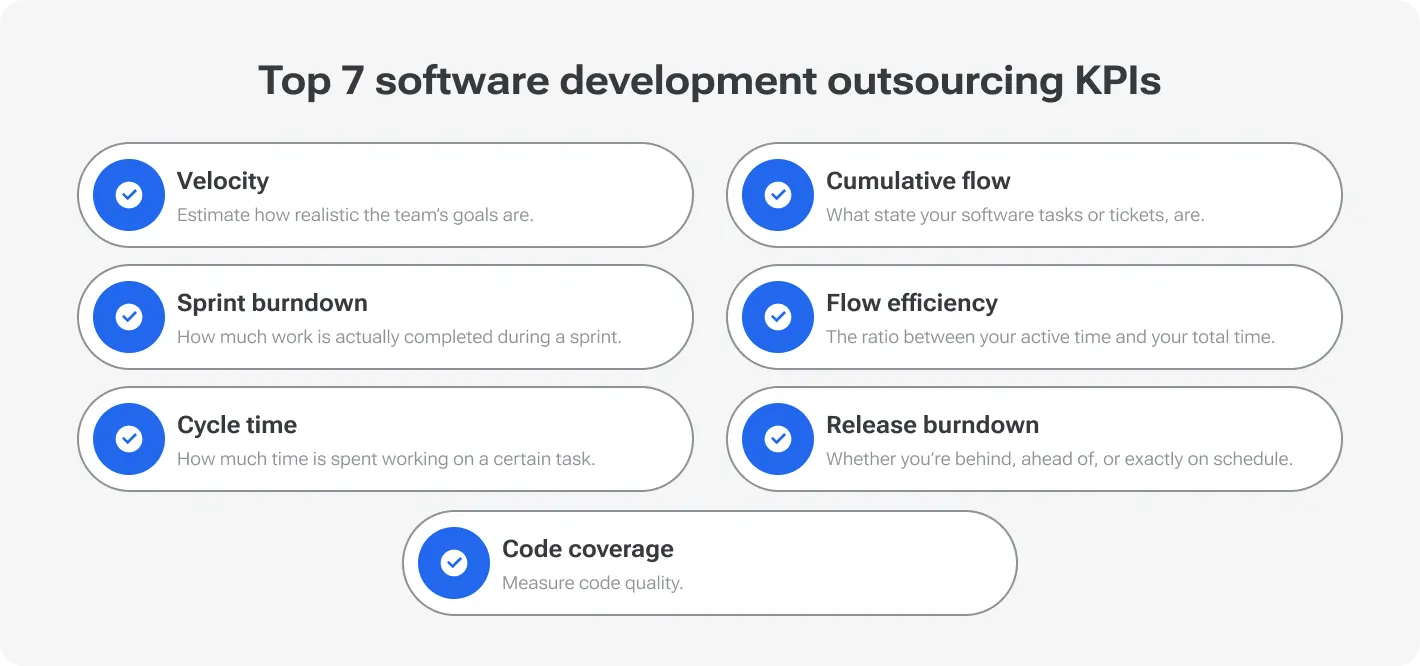According to recent estimates, 23% of employees working in tech quit their jobs each year. Losing one-fourth of the workforce per year is the key factor leading to significant disruptions, translating to costly downtime. It would be safe to say that in 2025, high turnover isn’t just a human resource statistic. It’s a strategic challenge for which every business and company wants to find a solution. When internal teams struggle with constant staff changes, the impact on project continuity can be severe. Projects do not meet deadlines, products are not released on time, and employees who are left lose sight of the common objectives.
In such a context, hiring offshore developers has emerged as a viable solution to minimize disruptions in this environment. Outsourced software development services can be the remedy everyone is looking for. It helps survive high-turnover phases and deliver products and projects on time.
Companies can maintain steady progress by outsourcing software development even when internal teams are in flux. Outsourcing and staff augmentation services ensure continuity, reduce costs, and strengthen resilience during turnover.
This article explores why and how outsourcing software development can be a critical strategy for scaling tech companies in 2025 to make sure you have some tangible insights after reading the piece.
Flexible trials for staff augmentation and expertise transitioning services
Adapting to the new era of software development outsourcing
With tools like DeepSeek and ChatGPT threatening to take software developer jobs, many businesses look for talent who can adapt fast. To stay competitive, startups and established companies must consider all the tech-related changes and find ways to turn disadvantages into advantages.
The key trends reshaping the industry
Technological advancements change how we build software. Now, software developers need to know how to code and prompt simultaneously.
While AI will unlikely replace software developers in the short run, it is evident that experts cannot omit collaborating with AI to bring the most benefits. In such a case, accepting this fact is important for knowing what type of talent you are looking for when hiring offshore developers.
Besides, remote work and digitalization have changed how companies operate. Digital tools let teams work together from anywhere. This shift gives businesses access to talent worldwide and affects many parts of work, including software development and outsourcing.
Now, it is time to speak about some key trends that are changing the outsourcing industry to the bone. Respectively, these three immediately come to mind:
-
Artificial intelligence (AI). New technologies allow for smarter, faster, and more efficient coding practices. Automation tools now help reduce repetitive tasks, while AI-powered development platforms can optimize code quality and accelerate time-to-market.
-
Remote and hybrid work environments. New work models make it easier for companies to tap into a global talent pool.
-
Investment in digitization. They need resources that can adapt to rapid changes.
The aforementioned factors have a direct positive impact on business flexibility, and they also help facilitate development outsourcing that meets the demands of today’s competitive markets. The more AI is involved in software development, and people stick to remote work, the bigger the interest in outsourcing, staff augmentation, nearshoring, offshoring, and more.
Why are companies rethinking outsourced software development services in the first place?
Outsourcing used to be mainly about saving costs. Today, companies view it as a strategic move. Naturally, if you know how to engage in optimized and efficient processes, you will save costs, translating into a competitive edge and a greater bottom line. Shifting priorities, stricter regulations, and the need for talent push these changes.
Firms now expect higher standards from their partners. They look for resources that can adjust as projects evolve. The new focus on quality and flexibility helps businesses keep pace.
Choosing between development outsourcing and in-house hiring. The strategic dilemma to deal with
Selecting either outsourcing or in-house hiring is a really important decision to make. Basically, to help you make the right decision, it is crucial to take a look at some key factors. We will focus on tech decisions, scaling, innovation, and cost-and-quality ratio.
Taking care of core vs. non-core tech decisions
The rule of thumb dictates — not every aspect of a technology project is equally important to a company’s strategic vision. There are core functions, such as:
proprietary product development;
customer experience design;
These often require strict in-house control. However, outsourced software development services can effectively handle all the non-core elements, such as:
specific feature implementations;
The role of software development outsourcing in scaling, innovation, and development
Outsourcing plays a vital role in scaling operations. The model provides the flexibility to quickly ramp up development capacity without the long-term commitment of full-time hires. When you do not need to spend time on hiring, recruitment, and onboarding, you get much more time on your hands.
Such agility is crucial for startups facing unpredictable market conditions. By tapping into external expertise, companies can focus on strategic growth. In other words, you get someone else to deal with operational and tactical levels while you can focus on the strategic realm.
To illustrate, a startup can outsource software development and QA testing to access experts in blockchain technology. It can help them launch a secure platform faster than if they had relied solely on internal staff. Besides, offering a blockchain-based service directly indicates the startup’s focus on innovation.
The case of balancing cost, quality, and agility
Every company faces trade-offs regarding cost, quality, and speed at some point in the lifecycle. In some cases, you need to speed up time-to-market, even if it means delivering an MVP instead of a polished product. On one hand, in-house development offers complete control over quality. Yet, it can be costly and slow due to recruitment and training delays. On the other hand, outsourcing software development can offer cost efficiency and speed. However, extra measures may be required to maintain quality and coordination.
In the end, when it comes to choosing between in-house hiring and software development outsourcing, consider whether you need to deal with core and non-core tasks. Besides, it determines the extent of the need for scalability and innovation. Finally, double-check if you can trade cost for quality and vice versa.
4 notable benefits of outsourcing software development in 2025
IT software development outsourcing today is more than a cost-saving tactic. It is a strategic advantage without exaggeration. When done correctly, outsourcing software development literally empowers companies to deliver products in time while scaling, innovating, and optimizing. Let’s take a closer look at the most widespread advantages development outsourcing can offer:
1. Global talent access
2. Faster delivery
3. Cost-saving
4. Facing talent shortage
Benefit 1. Global talent access and the chance to get experts with unique skills
One of the most compelling benefits of outsourced software development services is the ability to tap into a vast global talent pool. When local resources are limited or expensive, outsourcing provides access to specialized skills worldwide. This brings fresh ideas and innovative solutions and allows companies to address niche challenges precisely.
Benefit 2. Faster product delivery
Speed is paramount in today’s competitive landscape. Outsourcing projects as well as outsourcing staff, enables companies to accelerate development cycles and shorten time-to-market. By leveraging the efficiency of an experienced external team, companies can fast-track their product launches without compromising on quality.
Benefit 3. Cutting costs without cutting corners
Cost efficiency remains one of the primary drivers for outsourcing. Companies can achieve substantial savings by reducing the expenses associated with recruitment, training, and infrastructure. Importantly, these savings do not come at the expense of quality. Companies can maintain high standards while controlling budgets with the right outsourcing partner.
How does the offshore time difference work in your favor?
Benefit 4. Go through talent shortages and skill gaps smoothly
The tech industry is grappling with a severe talent shortage. It is challenging for companies to hire the right skills locally. Outsourcing offers a solution by providing access to an extensive network of experienced professionals. This approach bridges skill gaps and allows companies to respond quickly to project needs and market demands.
The aforementioned benefits offer many tangible results as well as promises. Yet, you must remember, to get the most out of the outsourcing advantages, it is crucial to take care of the potential challenges first. In the next section, we will invest more time in that exact topic.
Outsourcing-related risks, issues, and misconceptions
Despite its advantages, IT software development still faces many risks, issues, and misconceptions. Addressing these risks and misconceptions is key to getting the full benefit of outsourcing.
Is data security still an issue?
Data security remains a top priority for any tech company. Many worry that outsourcing software development might compromise sensitive information. With internal teams, you have strict security protocols and guidelines in place. In turn, with offshore teams, urging them to follow strict guidelines can be tricky.
Luckily, meticulous security practices and stringent contractual agreements allow businesses to significantly mitigate these risks. Today’s leading software development outsourcing companies invest heavily in cybersecurity and compliance measures.
Remedies to consider:
1. Implement robust data protection protocols.
2. Make sure outsourcing partners comply with industry-standard security certifications (such as ISO/IEC 27001).
3. Conduct regular audits and legal safeguards can further ensure data integrity.
The risk of mismanaging communication across multiple time zones
Communication challenges are often cited as a barrier to successful outsourcing. Differences in time zones, languages, and cultural nuances. These factors can lead to misunderstandings and delays.
However, when you understand the core of the problem and have the right tools in your arsenal, communication, and cultural issues can be dealt with. It all starts with understanding the roots of the given risk.
Potential solutions:
1. Establish clear communication protocols.
2. Schedule regular virtual meetings.
3. Use collaboration tools that facilitate real-time updates.
Remember, nearshoring or blended models help minimize the time zone gap. Along with offshoring and typical software development outsourcing, there are many more methods to choose from.
The misconception of quality to cost compromise
There is a common misconception out there. The one stating that outsourcing software development inevitably leads to lower-quality outcomes. In reality, many outsourcing partners specialize in their field and adhere to rigorous quality control processes. Outsourced teams can produce work that meets or exceeds in-house standards.
The key comes from proper oversight and collaboration protocols.
Workarounds:
1. Set clear quality standards.
2. Use performance metrics to monitor progress.
3. Conduct regular code reviews.
What is more, agile methodologies can ensure quality is maintained throughout the entire development cycle. However, before you start with such a methodology, make sure your team is ready for the shift, especially if you are considering a project-based staff augmentation and not a full-blow development outsourcing.
The delicate art of choosing the right software development outsourcing model
Not all outsourcing models are created equal. There are a number of methods to consider, namely nearshoring, offshoring, onshoring, staff augmentation, hybrid teams, and many more. To know which particular model suits best to your particular company or project, you need to go through the selection process.
Let’s go through such a process together and make sure you have all the insights needed to make the best possible decision.
Onshoring, nearshoring, and offshoring. Which software development outsourcing model fits your needs the best?
Each outsourcing model offers distinct advantages and drawbacks.
Onshore outsourcing provides the benefit of cultural and time zone alignment but often comes at a higher cost.
Nearshore outsourcing offers a compromise with relatively similar time zones and lower costs.
Offshore outsourcing is the most cost-effective option but may require extra effort in communication and management.
Knowing the benefits above, you have already set the stage for the accurate selection. Basically, take a look at your priorities. If you think language and cultural barriers will create the most problems, onshoring is your top pick. In turn, if you are after cost-effectiveness, offshore development outsourcing is a no-brainer.
Pro tip:
First and foremost, evaluate your project’s complexity, required level of collaboration, and budget constraints. These variables will guide you to one or another outsourcing model.
Blended models for hybrid teams and non-core tasks
If neither onshoring, nearshoring, or offshoring are clear options to pick, you need to consider mixing them together. A blended outsourcing model combines the best of both in-house and external resources. Such a hybrid approach allows companies to retain core functions internally while outsourcing non-core tasks. As a result, you get so-needed control while also staying flexible.
Pro tip:
Consider a hybrid software development outsourcing when you need to outsource specific components while keeping strategic functions in-house. For instance, if you don’t want your team to handle customer support and focus on product development instead, a hybrid model is a go-to strategy. Overall, the selected approach balances efficiency and innovation.
Understanding the difference between cost and scalability
Cost considerations vary significantly across different development outsourcing models.
1. Offshore outsourcing typically offers the lowest costs.
2. Onshore solutions may be more expensive but provide higher integration and oversight.
Scalability is another critical factor. It ensures your software development outsourcing partner can rapidly adjust resources as your project evolves.
Pro tip:
Analyze total cost of ownership (TCO). Then, evaluate the scalability options when selecting a partner. Finally, factor in both short-term savings and long-term benefits. Don’t forget to include flexibility and growth potential as variables of the equation.
The 3 scenarios when you should consider outsourcing software development
Development outsourcing isn’t a one-size-fits-all solution. If you see an outsourcing company position itself as a jack-of-all-trades, it should be a telltale sign that you need to look for a different partner. Outsourcing software development is most effective when applied strategically. Particularly, you need to consider scenarios where speed, scalability, or specialized expertise is critical.
Scenario #1. Need for speed in MVP launches for startups
For startups, launching a minimum viable product (MVP) quickly is often the key to getting market traction. IT software development outsourcing helps you tap into external expertise without the delays in building a full-time in-house team.
Add-on:
When time is of the essence, use software development outsourcing to build and iterate your MVP quickly. Focus on core functionalities in-house. Outsource supplementary components to speed up the development cycle.
Scenario #2. Scaling during growth spikes and high turnover periods
Quick growth often demands scaling software development teams quickly. Outsourcing projects and outsourcing staff offers the flexibility to ramp up resources during peak periods. You also get such a chance without the long-term commitment of hiring full-time staff.
In a similar case, if you face a high-turnover phase, outsourcing can be of great help. Imagine you have lost a couple of key software engineers at the most sensitive moment of the development cycle. You can quickly triage the wound by hiring offshore developers.
Add-on:
Use outsourced teams to handle surge capacity during growth spikes. Such an approach allows you to keep the development cycle running without compromising speed and quality.
Scenario #3. The case of integrating emerging technologies
Without a doubt, new technologies are looming. Think about AI, ML, IoT, and quantum computing. The more these technologies become common, the more the demand for specialized expertise becomes crucial. Outsourcing software development services allows companies to integrate these emerging technologies without requiring extensive internal training or hiring.
Add-on:
When venturing into emerging technologies, choose outsourcing partners with proven expertise. Don’t just believe hypothetical scenarios and words. Check case studies to understand whether a potential partner has real experience of working with projects related to AI, ML, IoT, RPA, and alike.
10 outsourcing trends to remember in 2025 and beyond
The scenarios above illustrate situations when software development outsourcing is the best strategy on the table. Remember, the model can help you in many more potential scenarios. However, there is a high likelihood that the aforementioned cases are the ones startups will face.
How to outsource software development successfully in 2025. A step-by-step guide
Successful outsourcing software development is all about having well-defined strategies. You need to deconstruct the bigger issue into smaller parts. Dealing with those is what the steps below show:
Step 1. Make sure to define objectives, KPIs, and OKRs properly
Before starting the overall software development outsourcing process, ensure you have clear KPIs, OKRs, and overall objectives. Besides, it is vital for everyone involved to have an understanding of what you are trying to achieve.
Step 2. Select and vet potential software development outsourcing companies for technical, cultural, and linguistic alignment
Choosing the right partner is very important. Beyond technical expertise, cultural fit is essential for good collaboration. Thoroughly vet potential vendors. Review portfolios and client testimonials.
If possible, conduct trial projects. Giving a potential vendor a test task is the best way to make sure they deliver.
Step 3. Build transparent communication channels
Clear, open communication is the cornerstone of successful software development outsourcing. Establish dedicated channels for regular updates, feedback, and issue resolution matters. Use project management tools.
Step 4. Establish strong legal, confidentiality, and IP protections
First and foremost, safeguard your intellectual property (IP) and ensure legal protections are in place. Then, draft comprehensive contracts that outline:
dispute resolution mechanisms.
If unsure, work with legal experts to develop contracts that protect your IP and define the responsibilities of all parties involved. Regularly review and update these agreements as needed.
Below is a checklist to help you choose the right software outsourcing partner for your startup. Use these 10 items to guide your decision-making process and keep your outsourcing journey on track:
1. Define clear project objectives and set measurable KPIs.
2. Develop a detailed project plan with specific milestones.
3. Research potential vendors' technical expertise.
4. Check vendors for cultural compatibility.
5. Review client testimonials and case studies.
6. Run a trial project to test vendor capabilities.
7. Set up regular communication channels with transparent reporting processes.
8. Use reliable project management tools.
9. Draft contracts to clearly define intellectual property rights.
10. Schedule regular reviews to assess progress as well as adjust plans as needed.
Successful software development outsourcing depends on careful planning and clear communication. With a well-defined plan and a trusted partner, your startup can manage growth and stay ahead in 2025 and beyond.
10 questions to ask your software development outsourcing vendor
Future-proofing your outsourcing software development strategy
As the outsourcing landscape evolves, businesses must be prepared for future challenges and opportunities. Future-proofing your outsourcing strategy is essential for long-term success.
Getting used to and adapting to AI-powered development tools
The integration of AI-powered development tools is transforming IT software development. These tools can automate routine tasks, enhance code quality, and improve project management. Outsourced teams can work more efficiently and deliver higher-quality outputs by using AI.
Here are some examples of AI tools to consider:
-
GitHub Copilot acts as an AI pair programmer. It suggests code and completes lines in several programming languages.
-
Amazon CodeWhisperer offers AI-driven code suggestions to reduce errors. It works well with AWS services and speeds up development.
-
Owlity is an AI-driven QA solution with a focus on automating testing, bug finding, and development.
-
Tabnine provides context-based code completions across multiple languages. It helps speed up coding by suggesting code as you work.
-
Kite is an AI assistant that allows code completion to help you code faster. It supports many editors and programming languages.
-
Microsoft IntelliCode uses AI to offer code suggestions within Visual Studio and Visual Studio Code. It helps boost productivity by learning from your coding patterns.
These tools help outsourced teams work efficiently and deliver quality software. Evaluate them to see which fits your development process best.
Using the power of IT outsourced teams to drive continuous innovation
Outsourced teams can bring fresh perspectives and innovative ideas that might not emerge within a fixed in-house team. This continuous influx of external expertise can drive innovation and keep your product competitive in a rapidly changing market.
Making a turn towards sustainable and ethical software development outsourcing
Sustainability and ethics are becoming increasingly important. Companies must deliver high-quality products and adhere to ethical labor practices and environmental standards. Besides, global guidelines anyone can follow. Aligning with outsourcing partners who share these values is crucial.
Prioritize vendors with transparent, ethical policies and sustainable practices.
Evaluate their corporate social responsibility (CSR).
Ensure your partners adhere to internationally recognized standards.
The key question: should you outsource software development in 2025?
In 2025, the decision to outsource software development remains a strategic one. Clearly, it is influenced by many factors. As we mentioned before, these include the "essential triad":
1. Cost
2. Quality
3. Speed
For startups facing rapid growth and talent shortages, outsourcing software development is much more than a cost-saving measure. It goes way beyond and can mean the difference between going extinct and staying afloat.
The benefits are clear. Whether through nearshoring, onshoring, or offshoring with the help of an outsourced software development company, or employing a hybrid development outsourcing model.
At Devico, we understand the complexities of outsourcing. Our services are designed to provide scalable, reliable, and cost-effective solutions. We always keep your needs and project requirements in the rear mirror.
With our polished-with-years approach to outsourcing projects and staff augmentation,, we are committed to helping you go through the turmoils of the evolving tech landscape and achieve sustainable growth.
End-to-end solutions with predictable budgets, a time-to-market advantage with budget savings of up to 50%






